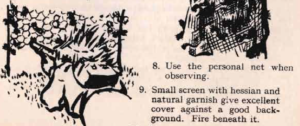I came across the interesting photo sequence shown here. Some time ago I made a post about the Vietnamese use of a framework on the back for camouflage. Here we see its use in action:
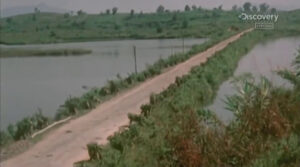
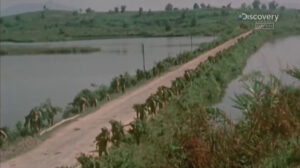
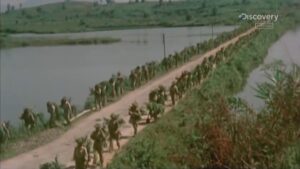
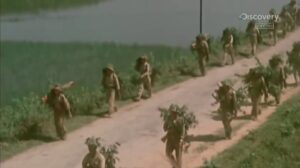
This is a Viet Minh force from the Indochina war. This trick was still in use in the Vietnam war.
Possibly at the sound of an aircraft, the men have moved off the road and dropped down. As the threat passes men “grow” first from one side of the road and the other.
The final image is a close-up. Interesting is that their uniforms appear to be beige rather than the green associated with the later NVA. VM Regular uniforms have been described as “khaki-drill” but apparently light-green, khaki and a variety of other drab shades were used.
According to Osprey Men at Arms 322, “The French Indochina War 1946-54.”:
“Viet Minh Regulars, and many Regional units, were first class; it is clear that they had successfully made the mental transition from guerrillas to soldiers. Neutral journalists who managed to spend time with Regionals were impressed by their discipline and preparedness. Throughout the VM attention to tactical detail was excellent, both in camp and on the march – great emphasis was laid on camouflage, night movement, dispersal and reassembly in the face of the enemy, and endurance with the simplest rations and minimal medical care and comforts.
“The VM were skilled at concealed cross-country movement in the worst terrain, carrying all essentials with them. This gave them significant advantage over motorised French troops, whose more complex logistical needs kept them tied to the inadequate and vulnerable road network. Generally only the best French paratroop units could match their cross-country speed in the jungle hills, and that for only limited periods. It was rare for French aircraft to inflict much loss on Regular units on the march, though their supply lines suffered much worse (e.g. in 1954, during the huge effort to supply the Dien Bien Phu siege army 500 miles from Viet Bae bases)…
“…Reports speak of Regulars carrying a wire mesh panel on their backs when on the march; at each halt the soldier changed the foliage camouflage of the man in front to match the locality exactly.”
Some WW2 British Manuals advocate the use of net or chicken wire screens for troops to hide behind or under. The back-screens described above could thus serve more than on application.
